Germany
February 3, 2015
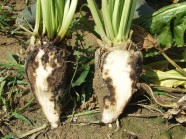
R. solani AG 2-2IIIB on sugar beet
Since the early ‘90s the late crown and root rot of sugar beet (Rhizoctonia solani AG2-2IIIB) causes yield and quality losses in German sugar beet growing areas. Besides the broad host range of the soilborne fungus, its occurrence in patches and the absence of chemical control products are the main reasons for the difficulties in controlling R. solani. It is known that R. solani occurs ubiquitously and the onset of the disease is strongly influenced by external factors like crop rotation, soil structure, soil moisture and temperature.
The aim of the project is to study the complex interaction of these factors using novel geo-referenced data analysis as well as molecular methods.
This three year large-scale research project is carried out in cooperation with the Institute of Sugar Beet Research in Göttingen (IFZ), the working group for promotion of sugar beet growing Regensburg (ARGE), and the German Weather Service (DWD). The project is funded by the Bavarian State Ministry of Food, Agriculture and Forests and the Südzucker AG. The project is split up in sub-projects. The sub-projects carried out by the Bavarian State Research Center (LfL) will be introduced in the following.
The aim of sub-project 1 is to identify risk factors for Rhizoctonia root rot disease in a large scale field study. For this purpose available geo-referenced data, weather data and crop rotation data of fields with sugar beet growing were evaluated for nine Southern Bavarian Districts. (supervised by Arbeitsgruppe Bodenphysik, Bodenmonitoring (IAB 1a) des Instituts für Ökologischen Landbau, Bodenkultur und Ressourcenschutz)
Sub-project 2
Quantification of Rhizoctonia soil inoculum densities using the quinoa-qPCR assay
The R. solani AG2-2IIIB specific molecular quantification method (quinoa-qPCR assay) established at LfL/IPS 3c will be used for real-time monitoring of the Rhizoctonia inoculum potential in soil. In sub-project 1 the quinoa-qPCR assay will be used for measuring the Rhizoctonia soil densities in identified Rhizoctonia risk areas. In sub-projects 3 and 4 the Quinoa-qPCR assay will be used for monitoring Rhizoctonia concentrations in the soil during experiments in the field and the growth chamber (phytotron). (supervised by Arbeitsgruppe Krankheiten in Blattfrüchten und Mais, Schädlinge und Wachstumsregler in Ackerbaukulturen (IPS 3c) des Instituts für Pflanzenschutz)
Sub-project 3
Investigations on the interaction between environmental factors, soil tillage strategies and the Rhizoctonia soil inoculum potential
Evaluation of hypotheses about the influence of physical and chemical soil properties (e.g. soil temperature, soil structure and soil moisture, variation due to different soil tillage, soil density and plant residues in the soil) on the Rhizoctonia soil inoculum potential (quinoa-qPCR assay, indicator plant assay) by conducting experiments in the field and in the growth chamber (phytotron). (supervised by Arbeitsgruppe Krankheiten in Blattfrüchten und Mais, Schädlinge und Wachstumsregler in Ackerbaukulturen (IPS 3c) des Instituts für Pflanzenschutz in Zusammenarbeit mit dem Institut für Zuckerrübenforschung/Abteilung Pflanzenbau und ARGE)
Sub-project 3A
Effect of soil structure and weather conditions on the Rhizoctonia inoculum potential in soil and infestation rates of sugar beets with R. solani
Sub-project 3B
Investigations on the relationship between soil density, soil moisture, soil organic matter and the Rhizoctonia soil inoculum potential in a controlled environment (phytotron)
Supplementary to the field trials (sub-project 3A) first tentative tests will be conducted in order to study the interaction between soil density, soil moisture, soil organic matter and the Rhizoctonia soil inoculum potential in a controlled environment in the phytotron. The indicator plant assay and the quinoa-qPCR assay will be used to monitor changes in the inoculum potential of R. solani in soil. Because of the dependence of field tests on year-specific environment variations, this sub-project studies to what extent experiments can be simulated under standardized environment in the phytotron. The advantage would be to provide results for the population dynamic of R. solani all-season and regardless of weather conditions.
Sub-project 4
Investigations on the impact of increased cultivation of crops like soybean and sorghum on the Rhizoctonia soil inoculum potential during crop rotation cycles with sugar beet
This sub-project studies in line with a three year field test, the impact of energy and protein crops like maize, sorghum, soybean and wheat as part of crop rotation sequence patterns with sugar beet on the soil inoculum density of R. solani AG2-2IIIB and the incidence of the Rhizoctonia root rot disease in all crops investigated. (supervised Arbeitsgruppe Krankheiten in Blattfrüchten und Mais, Schädlinge und Wachstumsregler in Ackerbaukulturen (IPS 3c) des Instituts für Pflanzenschutz in Zusammenarbeit mit ARGE)
Typical R. solani AG2-2IIIB symptoms

round patches with damaged plants in beet fields

rotted crown and root
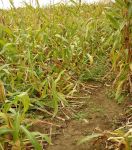
crops with higher tendency to lodge
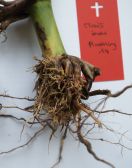
reduction of root tissue, damaged prop roots and typical Rhizoctonia “eyespot” on the stem

crops with higher tendency to lodge
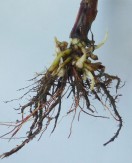
reduction of root tissue

soybean field in crop rotation with sugar beet
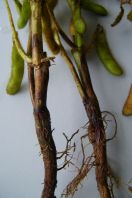
reddish brown, sunken lesions on hypocotyl
Learn More
"Girth scab" of sugar beet, caused by Aphanomyces cochlioides
‘Girth scab’ of sugar beet is a characteristic disease of mature sugar beet roots. It is, however, often detected not before harvest: upper parts of the plants, including the leaves will remain almost entirely healthy, while beet roots below soil line are typically scabby, irregularly fissured, darkly discoloured and covered with large patchy and suberised necroses. Mehr
Integrierte Kontrollstrategien gegen die Späte Rübenfäule der Zuckerrübe (Rhizoctonia solani)
Die Späte Rübenfäule der Zuckerrübe, ausgelöst durch Rhizoctonia solani AG2-2IIIB, verursacht in Deutschland seit Anfang der neunziger Jahre Ertragsausfälle und Qualitätsverluste im Zuckerrübenanbau. Die Hauptgründe für die schwierige Bekämpfung des Erregers sind, neben dem breiten Wirtsspektrum des bodenbürtigen Pilz, das nesterweise Auftreten im Boden sowie das Fehlen von chemischen Kontrollmöglichkeiten. Es ist bekannt, dass R. solani in praktisch allen Ackerböden vorkommt und das Auftreten von Schadsymptomen von äußeren Faktoren wie Fruchtfolge, Bodenstruktur, Bodenfeuchte und Temperatur stark beeinflusst wird.
Das komplexe Zusammenspiel dieser Faktoren soll im Rahmen des Projekts an der LfL mit neuesten geo-informatischen sowie molekularbiologischen Methoden untersucht werden.
Es handelt sich um ein gemeinsames Forschungsvorhaben mit dem Institut für Zuckerrübenforschung (IfZ), der Arbeitsgemeinschaft zur Förderung des Zuckerrübenanbaus Regensburg (ARGE) und dem Deutschen Wetterdienst (DWD). Gefördert wird das Projekt durch das Bayerische Staatsministerium für Ernährung, Landwirtschaft und Forsten sowie durch die Südzucker AG. Das Forschungsprojekt ist in mehrere Teilprojekte untergliedert, nachfolgend werden die von der Bayerischen Landesanstalt für Landwirtschaft (LfL) bearbeiteten Teilprojekte kurz vorgestellt.
Beschreibung der Teilprojekte
Teilprojekt 1
Feldstudie zur Identifikation von Rhizoctonia-Risikostandorten durch Verknüpfung von Geo-, Niederschlags-, Bewirtschaftungs- und Rübenwertminderungsdaten
Ziel des Teilprojekts 1 ist es, im Rahmen einer umfassenden Feldstudie Risikofaktoren für einen Befall mit R. solani zu identifizieren. Dazu werden in neun südbayerischen Landkreisen verfügbare Daten zu Bodeneigenschaften, zum Witterungsverlauf und zur Fruchtfolge von Feldern mit Zuckerrübenanbau ausgewertet. Die Bearbeitung übernimmt die Arbeitsgruppe Bodenphysik, Bodenmonitoring (IAB 1a) des Instituts für Ökologischen Landbau, Bodenkultur und Ressourcenschutz.
Teilprojekt 2
Quantifizierung des Rhizoctonia-Boden-inokulums
Unter der Verwendung der an der LfL entwickelten R. solani AG2-2IIIB spezifischen qPCR-Quantifizierungsmethode soll an Hand von Bodenproben von identifizierten Risikostandorten (TP1) und den Experimenten im Phytotron (TP3B) und Feld (TP3A + TP4), der Zusammenhang zwischen Symptomausbildung an der Pflanze und der Rhizoctonia-Konzentration im Boden bestätigt und nachverfolgt werden. Die Bearbeitung übernimmt die Arbeitsgruppe Krankheiten in Blattfrüchten und Mais, Schädlinge und Wachstumsregler in Ackerbaukulturen (IPS 3c) des Instituts für Pflanzenschutz.
Teilprojekt 3
Untersuchung des Zusammenhanges zwischen Umweltfaktoren, Bodenbearbeitungs-strategien und dem Rhizoctonia-Bodeninokulumpotential
Durch Versuche im Feld sowie durch erste Tastversuche im Phytotron werden Hypothesen zum Einfluss physikalischer und chemischer Bodeneigenschaften (u.a. Bodentemperatur, -struktur und -feuchte, Variation durch differenzierte Bodenbearbeitung und -belastung sowie Erntereste) auf das Rhizoctonia-Bodeninokulum überprüft. Die Bearbeitung übernimmt die Arbeitsgruppe Krankheiten in Blattfrüchten und Mais, Schädlinge und Wachstumsregler in Ackerbaukulturen (IPS 3c) des Instituts für Pflanzenschutz in Zusammenarbeit mit dem Institut für Zuckerrübenforschung/Abteilung Pflanzenbau und ARGE.
Teilprojekt 3A
Einfluss von Bodenstruktur und Witterung auf das Rhizoctonia-Inokulumpotential im Boden und den Rhizoctonia-Befall von Zuckerrüben
Teilprojekt 3B
Untersuchung des Zusammenhanges zwischen Bodendichte, Bodenfeuchte, infizierten Ernteresten und dem Rhizoctonia-Bodeninokulumpotential unter kontrollierten Umweltbedingungen (Phytotron)
Ergänzend zu den Feldversuchen (TP 3A) werden erste Tastversuche unter kontrollierten Umweltbedingungen im Phytotron durchgeführt. Es soll der Zusammenhang zwischen den Umweltfaktoren Bodenfeuchte, Bodendichte, organischer Bodensubstanz und dem Rhizoctonia-Bodeninokulumpotential untersucht werden. Die Rhizoctonia-Befallsdynamik und die Veränderungen des Inokulumpotentials werden mittels qPCR- und Indikatorpflanzen-Assays überwacht. Da Feldversuche stark von jahresspezifischen Umweltbedingungen abhängig sind, wird geprüft inwieweit Versuche unter standardisierten Bedingungen im Phytotron die Feldversuche nachbilden können. Der Vorteil wäre es, witterungsunabhängig und ganzjährig Ergebnisse zur Populationsdynamik von R. solani liefern zu können.
Teilprojekt 4
Untersuchung des Einflusses des zunehmenden Anbaus von Kulturen wie Sojabohne und Sorghumhirse auf das Rhizoctonia-Bodeninokulumpotential innerhalb von Zuckerrüben-Fruchtfolgen
In Teilprojekt 4 wird im Rahmen eines dreijährigen Feldversuches geprüft, ob Energie- und Eiweißpflanzen wie Mais, Sorghumhirse und Soja sowie Weizen als Nichtwirtspflanze in Fruchtfolge mit Zuckerrüben das Bodeninokulum von R. solani AG2-2IIIB sowie das Auftreten der Späten Rübenfäule beeinflussen. Die Bearbeitung übernimmt die Arbeitsgruppe Krankheiten in Blattfrüchten und Mais, Schädlinge und Wachstumsregler in Ackerbaukulturen (IPS 3c) des Instituts für Pflanzenschutz in Zusammenarbeit mit ARGE.
Typische R. solani AG2-2IIIB Schadsymptome

Nesterweises Absterben von Zuckerrüben auf dem Feld

Fäulniss durch R. solani AG 2-2IIIB am Rübenkörper

Maislager verursacht von Rhizoctonia

Rhizoctonia an Mais

Lager bei Sorghumhirse verursacht durch R. solani

R. solani an Sorghumhirse

Sojafläche im Fruchtfolgeversuch mit Zuckerrüben

R. solani an Sojabohne
Mehr zum Thema
„Gürtelschorf“ der Zuckerrübe durch Aphanomyces cochlioides
Der „Gürtelschorf“ der Zuckerrübe ist ein charakteristisches Krankheitsbild an älteren Rüben, das zwar leicht von anderen Rübenfäulen zu unterscheiden ist, aber bisweilen erst bei der Ernte bemerkt wird. Die Ertagsausfälle und die wirtschaftlichen Auswirkungen bleiben zwar meist eher gering, schlagweise können die Erntemenge und die Qualität der geernteten Rüben jedoch stark reduziert sein. Auch die Lagerfähigkeit der geernteten Rüben sinkt durch den Befall. Mehr